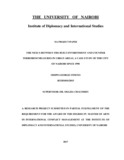| dc.description.abstract | Nairobi and other major cities of the world are facing significant threats from
international and local terrorism. The previous attacks show that crowded places like
open air markets and public buildings remain attractive targets. Consequently, the built
environment, which includes buildings, infrastructure and land use, becomes the stage
upon which these heinous acts of terrorism are planned and executed. Any anti-terrorism
effort must therefore create safer places and buildings that are less vulnerable to terror
attack and in case of any attack, lives and properties are protected from its impact. The
guiding principle is that the more a bomb or an improvised explosive device is separated
from the building or target, the lesser the effects are felt. The main objective of the study
is to analyze the resilience of the built environment against the global threats of terrorism
in urban areas with particular emphasis on the city of Nairobi, Kenya. The study has
adopted frustration aggression theory while specific objectives of the study include: to
explore the relationship between the built environment and counter terrorism measures in
urban areas; to highlight the exposed nature of urban areas to threats of terrorism under
the currently non resilient structure; and to identify current and future resilience features
of the built environment to threats of terrorism in the Nairobi City. The research design
used in this study was descriptive survey method. The study adopted an interview
schedule. Data has been mainly derived from secondary and primary sources. The
interviewees were the National Environmental Management Authority (NEMA) and The
Nairobi City County (NCC), specifically the Director City Engineer’s Department, City
Planning Department and the Housing Development Department (Development Control).
The concept of a resilient built environment is a recent social construct that includes
buildings, infrastructure and land use that can offer inbuilt protection to users. In the fight
against terrorism, questions have been asked regarding the role of professionals in the
building industry like architects, engineers, urban planners and quantity surveyors among
others. It is possible for engineers to design building structures that can either withstand
or reduce the impact of detonated bombs. Architects can also design buildings that can
delay either the attacks or discourage sustained attacks. However, the input of these
professionals has never been sought in the fight against terror; leave alone the need for a
resilient built environment. This study highlights the connection between the built
environment and the fight against terrorism. Some of the key findings are that the
increasing problem of traffic jam, construction of commercial complexes and office
blocks in residential zones, the absence of buffer zone of some distance between the
security check point and most public buildings in Nairobi, lack of building bylaws
touching on threats of terrorism and even lack of enforcement of the already existing ones
are all creating very fertile targets for terrorist attacks The study recommends that the
county government of Nairobi must enact building bylaws aimed at reducing terrorism,
its effects and threats. Areas that must be looked at are design of public buildings like
malls and traffic jam. | en_US |



